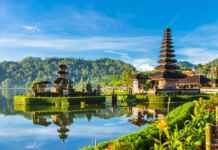The Belize Barrier Reef essentially refers to a series of coral reefs straddling the coast of Belize. Spread across a 300-kilometer long section of the Mesoamerican Barrier Reef System, it extends from the border with Mexico to the north, to near the Guatemalan border to the south. After the Great Barrier Reef in Australia and the New Caledonia Barrier Reef, it represents the world second largest reef system and the largest reef complex in the Atlantic-Caribbean area. The Belize Barrier Reef is Belize’s top tourist destination and is particularly popular for the scuba diving and snorkeling activities it offers.
In Belize, the coastal waters were used extensively for fishing by the Mayans between 300 B.C. and 900 A.D. It is believed that this system resulted from the accumulation of coral fragments along with silt from the Rio Hondo. Charles Darwin described the Belize Barrier Reef as “the most remarkable reef in the West Indies” in 1842. In fact, this reef happens to be one of the largest barrier reef in the northern hemisphere. To the east of the Barrier Reef are three separate atoll reefs, Lighthouse Reef, Turneffe Atoll and Glovers Reef.
All the main types of reef are represented in the Belize Barrier Reef. One of the most diverse ecosystems of the world with 90% of the reef still needing to be researched, it is estimated that only 10% of all species have been discovered. Today, it is home to about 65 coral species and over 300 fish species. On the biodiversity scale, only rain forests rank higher than this reef. This huge diversity is due to the fact the reef is carefully partitioned by all its inhabitants. This means that all species use the reef at different times of the day.
Today, there are many threats to the Belize Barrier Reef, which have already seriously degraded an estimated 10% of its coral reefs and currently threaten a much greater percentage. Sedimentation, agrochemical run-off, coastal development and overfishing are some of the major factors which contribute to the degradation of the reef.
How To Reach Belize Barrier Reef
In order to access the Belize Barrier Reef, the best bet for visitors is to take a flight to the Philip S. W. Goldson International Airport in Belize City. From there, the reef can be easily reached.
Climate
As far as the weather in Belize is concerned, this region experiences a tropical climate. It is characterised by a lot of humidity and precipitation. The dry season is from the months of February to May. The period between June to November witnesses numerous hurricanes in the area, resulting in coastal flooding, especially in the south. Rainfall is unpredictable and can occur in any month across the year.
For the adventure enthusiastic travellers, Belize Barrier Reef is definitely worth a trip!










